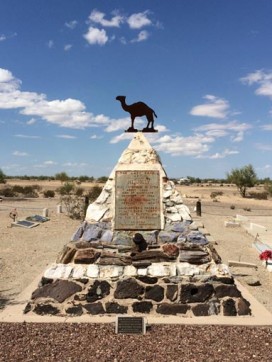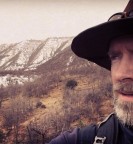Hi Jolly - The Camel Driver

From late summer of 1857 to the winter of 1858, retired Navy Lieutenant Edward Fitzgerald Beale surveyed the 1,240-mile 35th Parallel Route from Ft. Smith, Arkansas, to the Colorado River (Beale 1858). In 1859, Beale’s road construction party was accompanied by the trial run of military camels as beasts of burden for the wagon road he constructed (National Park Service [NPS] 1977). The lead driver of this famous expedition was Ali al-Hajaya (born ca. 1828), an immigrant from the Levant and an Ottoman Turkish citizen who had accompanied the shipment of camels destined for military service across the Atlantic from the Middle East.
According to some sources, al-Hajaya was born Philip Tedro and in order to give the impression he was of Middle Eastern descent once he reached U.S. soil, Tedro called himself Hajj Ali (Amer 2013). Other sources record his name as Ali al-Hajaya, a Muslim who earned the title hajji after completing the Hajj pilgrimage to Mecca, and later adopted the name Philip Tedro when he became a U.S. citizen in 1880 (Abu Deeya 2010). Either way, as those working around him did not speak Arabic, his fellow drivers soon took to calling him “Hi Jolly,” based on the sound of his nickname (Amer 2013).
With the aid of twenty-two camels, fresh from the Middle East, carrying supplies and tools for Beale and his crew of 50 men, the Camel Corps successfully aided in the construction of the wagon road along the 35th Parallel Route. Beale described these “ships of the desert” as surprisingly effective at packing heavy loads across the dry, rocky landscape (USFS 2015). Others, however, did not share the lieutenant’s favor of the animals, considering them foul smelling, evil tempered, and ugly. The Camel Corp’s efforts ultimately proved successful, resulting in the Southwest’s first federally funded interstate road consisting of a 10-foot-wide track with the rocks pushed to the side to smooth the way for wagons.
The experiment ended with the onset of the Civil War, and many of the camels were either sold or abandoned. Hi Jolly remained in the southwest, initially attempting to run a freighting business using a few camels he kept from his earlier endeavors. When his business failed, he released his camels into the deserts near Gila Bend, Arizona. Hi Jolly attempted other ventures, such as delivering mail, working occasionally for the U.S. Army, and finally took up residence in what is today Quartzsite, Arizona. Here, Hi Jolly prospected and mined on occasion, as well as scouting for the U.S. Government (Amer 2013). He lived out his remaining days in Quartzsite, dying in 1902.
Today, Hi Jolly is buried in the Quartzsite Cemetery. In 1935, the Arizona Highway Department built a rubble-stacked pyramid of native quartz and petrified wood, topped with the dark silhouette of a metal camel, on Hi Jolly's grave as part of efforts to publicize US 60 (Figure 1). As the result of Hi Jolly's efforts, and those of his fellow camel drivers, the 35th Parallel Route became known as the Beale Camel Trail (Beale Wagon Road, today). Portions of the Beale Wagon Road are now listed in the National Register of Historic Places.
References
Abu Deeya, Sayyid 2010 - Jordanian Legend Makers: Hajj Ali [translated from Arabic by Annie J. Lutes]. Ammon News. Available at: Review Here. Accessed September 9, 2015.
Amer, Sahar 2013 - Muslim Immigration: Hi Jolly. Arabs in America. Available at: Review Here. Accessed September 9, 2015.
Beale, Edward Fitzgerald 1858 - Wagon Road from Fort Defiance to the Colorado River. 35th Congress, 1st Session, House Executive Document No. 124. Government Printing Office, Washington, D.C.
National Park Service (NPS) 1977 - National Register of Historic Places, 35th Parallel Route (Beale Camel Trail), Holbrook, Apache County, Arizona, National Register No. 77000129. U.S. Department of the Interior, National Park Service, National Register Branch, Washington, D.C.
United States Forest Service (USFS) 2015 - The Beale Wagon Historic Trail. Williams Ranger District, Kaibab National Forest. Available at: Review Here. Accessed December 2, 2015.
Download Hi_Jolly_111515.pdf- Tagged In: Beale Wagon Road, Hi Jolly, History

Joshua S. Edwards
Josh is the Principal Investigator for Cornerstone Environmental in Flagstaff, Arizona. He is an archaeologist, geomorphologist, and faunal analyst specializing in research topics oriented toward Southwest prehistory. This has included research on changes in prehistoric settlement patterns and subsistence strategies, anthropogenically induced paleoenvironmental change, and fluvial system dynamics and their effect on cultural landscapes. His work has been geographically focussed in Arizona and western New Mexico, and includes projects in California, Nevada, Colorado, Utah, Wyoming, and Texas. Also having a passion for history, Josh loves reading about local historical events and people. This has led him to learn the intricacies of historic preservation. Applying these principals has been an ongoing challenge and has fulfilled his desire to continue learning and expanding his abilities within his academic and professional field.










